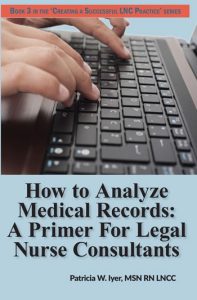Top 10 Hints for Medical Records Management
 Legal nurse consultants are often involved in medical records management. Here are some tips to make the job of organizing medical records go more smoothly.
Legal nurse consultants are often involved in medical records management. Here are some tips to make the job of organizing medical records go more smoothly. 1. Let the attorney know if you need a certified medical record or an abstract. A medical malpractice case involving a specific admission would be difficult to evaluate without a full certified copy of the medical records.
2. Be aware that the production of the nursing home chart is regulated by the Federal Government. Under 42 CFR 483.10, the nursing home is required to produce a medical record within 2 working days of a request. “The resident or his or her legal representative has the right (1) upon an oral or written request, to access all records pertaining to himself or herself, including the clinical records, within 24 hours (excluding weekends and holidays); and (2) after receipt of his or her records for inspection, to purchase at a cost not to exceed the community standard, photocopies of the records or any portion of them upon request and two working days advance notice to the facility.”
Your plaintiff attorney client may complain about difficulty getting nursing home records. If a nursing home is not responding to requests for records, let your client know about this statute.
3. Use a logical, consistent way to organize each medical record. You will save hours of looking for material if you do so.
4. Don’t accept a poor quality copy of a medical record. A poor copy may be light, misfed into the copier so that only part of the page is visible, or missing pages. A copy that is double sided, with the pages jumbled and placed front to back in random order, will be almost impossible to follow and to organize. Ask the attorney or paralegal to request a better copy.
5. Don’t put yellow or pink highlighting on the medical records you forward an expert. The expert may have to explain that highlighting in a deposition one day. The other side may assert that the highlighting assumes the expert cannot find the relevant material without hints from the attorney or legal nurse consultant.
6. Don’t jumble medical records. Hospital and nursing home records should be organized chronologically within each section of the records. For example, the physician orders should start with the initial set written when the patient was admitted to the hospital, and end with the discharge order.
7. Use a magnifying strip, sheet or a copy enlarged on a copier to decipher small handwriting.
8. Ask the attorney if he or she has retained a set of medical records. Don’t send an expert the only copy of the medical records. You or the attorney may need to refer to them while the expert has them.
9. Don’t send medical records by a method by which they cannot be tracked if lost.
10. Don’t send physician’s office records without identifying the name of the physician on a cover sheet or without the records request letter. It may be difficult for the expert or consultant to determine the author of the records without this identification.
 It is easier to work through the steps of medical records management when you consistently handle medical records the same way.
It is easier to work through the steps of medical records management when you consistently handle medical records the same way.
Get even more help with medical records management by investing in a copy of my book, How to Analyze Medical Records.
